► Huracan LP610-4 on long-term test
► Can you really live with one every day?
► We truly did, for six months. Read the full diary here
Month 6 running a Lamborghini Huracan LP610-4: the conclusion to our long-term test
Well, after 8188 miles since July, including a day lapping Rockingham and a 190mph run on the autobahn, you can’t say we haven’t used it – and could even argue we abused it, though I promise the roadkill/rear arch-liner interface reported last month most definitely wasn’t avoidable. But our short stint of life with a Lamborghini Huracan has now come to an end, and it leaves a gaping hole that not even Ben Miller’s McLaren 650S can fully absolve.
There’s just something about a Lambo that brings out the schoolboy in everybody – the opposite sex included. It’s like an aura, which goes beyond raw performance and enters the realm of what, for want of a better word, we’ll call theatre. It’s not just the swivelling heads – prompted by the industrial timpani of that 5.2-litre naturally aspirated V10, held by the madcap elegance of those angular, ground-hugging aesthetics – but the positive appreciation it attracts from (almost) everyone who encounters it. People loved seeing this car, to such an extent that many broke that traditionally aloof British resolve and took the trouble to compliment it. Nothing else I have ever driven has so comprehensively enthralled.
As the mileage tally suggests, this was no garage queen. I drove it every day that I didn’t have to be driving something else, to such an extent that curious colleagues practically had to best-of-three me at Rochambeau in order to prise away the keys. It lived out in the open, on my driveway, every night – and although this means at the bottom of a cul-de-sac, largely obscured by a hedge, this didn’t stop the doorbell ringing of an evening, usually at the behest of a group of local kids. There was never any trouble though. Unless you count the occasion it was parked outside my parents’ house in Dorset and somehow prompted every passing genius to pause and rev their engine for a moment. That’s one way to show your enthusiasm.
So, what’s it like to daily-drive a Huracan? Genuinely, an unrelenting pleasure. Sure, the seats caused complaints, refinement isn’t a strong point, and I would rate the visibility as ‘good enough’ rather than perfect (certainly, you can see more out of the back of a new R8), but if you can afford the running costs there really isn’t anything to worry about. I did see a few a warning lights, but these were all related to misbehaving sensors rather serious component failures – it was an early-build car – meaning the biggest technical issues I encountered were a slow puncture (£540 for a new rear) and a malfunctioning washer jet (fixed under warranty). Other motorists were always happy to let it out at junctions, and there was no sense of getting bored with the performance. That I kept my licence clean will go down as one of the wonders of the universe.
With maximum commitment, this 602bhp wedge doesn’t so much accelerate as jump in time and space. I’ll miss its ability to instantly silence passengers, if not the (very) occasional angst it caused by suddenly materialising behind slower traffic; no matter how much space you leave, the sudden presence of a Lamborghini does apparently have the facility to shock. Whether you’d say the same of the fuel bill is between you and your accountant; suffice to say my next car is going to be less profligate…
By CJ Hubbard
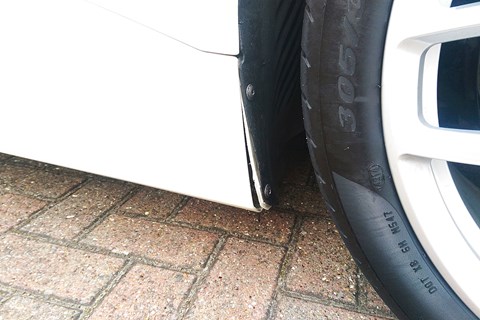
Month 5 running a Lamborghini Huracan: our Lambo hits trouble (well, some roadkill)
BAM! Things you never think about until there’s trouble include wheelarch linings. In particular the leading edge of the Huracan’s rears, which are lower than the bottom of the car. Meaning that when I took someone else’s extra large roadkill – muntjac? Particularly fat badger? – under the nearside wheels the poor thing tore said lining right out of its mountings. The choice between weeks waiting for a replacement side skirt or a bit of glue wasn’t a tough one…
By CJ Hubbard
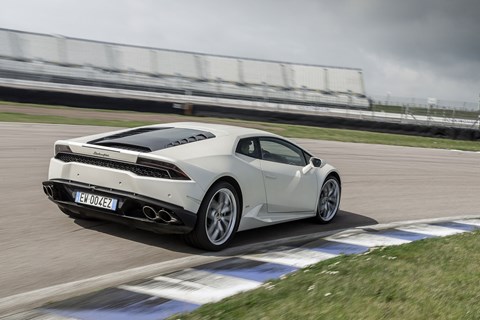
Diary update: Lambo thrills alive and kicking
Has the Huracan become too sensible? A mite too much Ingolstadt polish and not enough Sant’Agata red blood? There were whispers of this when we first drove the car in 2014. But on the evidence of our long-term test car, I’m not feeling it. There’s more polish, more maturity than a Gallardo, certainly – but the longer we live with the LP610-4, the more we uncover its raging Lamborghini heart.
There is raw drama aplenty, maybe just expressed differently. From the moment you ogle it in the car park – all low-slung arrowhead design, outrageous contours and scoops slightly mellowed from the full-fat V12 models – to the time you lift the doors and slide into the theatrical cabin; there’s drama every step of the way. Particularly so in our luridly Kermit green interior, where your senses are attacked by bright colours, slightly infantile Atari-spec graphics and that monstrously charismatic V10 over your shoulder.
I think the Huracan has matured in the same way most models do in the transition from v1 to v2. Don’t forget, Lamborghini didn’t sell a smaller Ferrari V8 rival until the Gallardo arrived in 2003. The fact that the new starter Lambo is slicker is to be expected, but when you pass a derestricted sign and the road clears, it remains a special place to be: agile of steering, surprisingly easy of visibility, that shock-n-awe exterior shrinking around you, the twin-clutch transmission zipping up and down the gears with playful – and tuneful – abandon.
It’s every inch the junior supercar. We’re enjoying getting to know it very much indeed and that Audi connection means that we’re using it every single day, come rain or shine.
By Tim Pollard

Month 4 running a Lamborghini Huracan: life in the very, very fast lane
From maybe a kilometre back, it’s difficult to tell if it’s a 1-series or 3-series convertible, meandering at about 100mph in the outside lane. In the time it takes to process that thought, it resolves to become clearly a 1-series. Still meandering. I start flashing the headlights. I keep flashing the headlights. I’m going to have to lift. I lift. Then it moves – and my right foot is back to the floor before it’s even fully evacuated the lane. Dusk is looming, and the sensible version of my consciousness, currently cowering somewhere at the very back of my brain, presumably in the vicinity of the thickest part of my skull, stutters that this probably is the last shot at this ridiculous enterprise. Go. Go go go!
Something has been bothering me about the Huracan since the day it arrived. With 8166 miles on the clock, obviously it had been driven – and being a Lamborghini, obviously it had been driven hard. But it was ever so slightly galling to flip through the supplementary displays at the periphery of the digital instrument panel and discover that the highest recorded speed was 182mph.
Now, while that display option is easily hidden – it’s not often I need the accompanying lap timer on the A14 – the knowledge that some other bugger has driven ‘my’ car not just faster than me but very fast indeed started to niggle. Since life is short and I won’t have the keys to a Huracan forever, I began to ponder how to make amends. I’m not especially competitive, so this only happened immediately.
Taking it to a v-max straight-line event seemed too supercar boys club and boring – plus I can’t imagine myself ever getting an invite. We did briefly look at closing a suitable stretch of the UK road network, but it turns out those new regs for motorsport on public tarmac don’t apply in this instance. Which left one option. Germany.
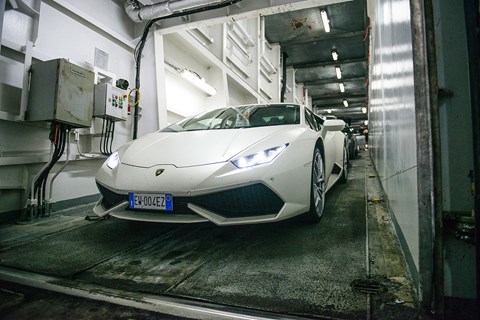
It didn’t take much googling to find that the best candidate for derestricted autobahn within easy reach of the UK is the A5 heading south out of Hattenbach. This rang a vague bell, and with a little more digging I soon learned that the A5 was once known as ‘the Führer’s autobahn’ – being the first Reichsautobahn built under Hitler’s rule (though not actually the first in Germany). More significantly, the initial section constructedlinking Frankfurt and Darmstadt, was the location of the Mercedes-Benz and Auto Union Silver Arrows’ land-speed record activities in the late 1930s. These days, this eight-lane über-bahn is known in some quarters as the Frankfurt drag strip.
Was I really about to try and exceed 182mph – a speed almost certainly set on track during the Huracan’s press activities prior to its arrival at CAR – on a public highway?
Lest you think this incredibly reckless, let me disabuse you: it’s not just reckless, it’s downright dangerous. Which will hopefully lead you to understand that I wasn’t taking it lightly. On 28 January 1938 Rudolf Caracciola wound his Mercedes-Benz W125 Rekordwagen up so hard he achieved an average speed of 268.9mph over the flying kilometre and 268.7mph over the flying mile on this very motorway, new world records both; later the same day, Bernd Rosemeyer was killed trying to beat him, when something no-one entirely understands sent his Auto Union V16 Streamliner into the scenery at between 250 and 280mph. The Huracan is by no means that fast, of course, and it has all the advantages of modern aerodynamics – but Caracciola and Rosemeyer weren’t in traffic.
Precautions are paramount. This meant taking blatant advantage of our relationship with Lamborghini UK to have the Huracan thoroughly checked over by Lamborghini London before setting off. We weren’t explicit about what we planned to do – so no blame can be attached to either of them – but we did say we were heading for Germany and wanted to make sure the car was firing on all cylinders physically and metaphorically. I also became mildly obsessed with checking the tyre pressures, no matter that the Huracan has an on-board monitoring system. Blame last month’s puncture and a healthily overactive imagination.
I was also careful not to make the speed the be-all and end-all of the trip, adding some sightseeing activity as part of the adventure. With hotels and ferries booked – the ferry being judged far less of a threat to those precious 19-inch wheels – and photographer Alex fully apprised of what he was letting himself in for, we were on our way. Amazingly, all his gear went in the front, leaving the space behind the seats free for the stuffing of our archetypal squashy bags. We swallow up most of Belgium in a single massive lunge, arriving at our hotel in Verviers late but relatively unruffled. I optimistically reset that max speed indicator. No going back now.
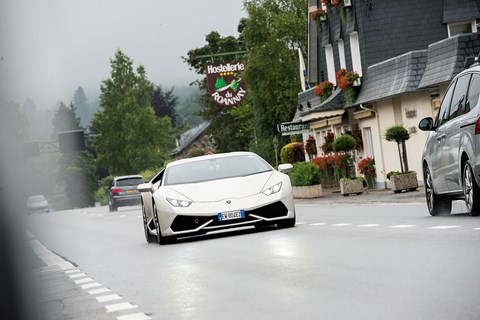
A quick blat round the old Spa-Francorchamps street circuit does wonders for your perspective. Particularly in the rain. So it’s with cool heads that we turn towards Germany’s limit-free paradise in the morning – but with over 160 miles to cover to get to Frankfurt, once we cross the border I’m soon taking advantage of every derestricted sign. While these ghost-like cousins of the UK’s national limit indicators supposedly only mean flat-out in fine weather, I have to get a feel for the Huracan’s behaviour at higher velocities. And besides, we’re in danger of being an obstruction if we don’t get a wriggle on.
For there’s further perspective on this idiotic endeavour once you’re running at speed on the autobahn – which is that the Germans really do love to drive fast. As the precipitation fades I quickly find that if I’m not right back on it the instant the traffic clears I’m gapped by the 320d in front and have the Audi V6 TDI behind practically inside the engine compartment, diagnosing the fault with the Huracan’s 602bhp V10. The sense that you’re doing something illicit is swiftly replaced by a calm, concentrated normality, where 120mph becomes de rigueur and you’re frustrated by anyone doing anything less.
The Huracan is happy to go faster. Much faster. I’d almost reached such a point of familiarity with this car that I wasn’t sure it could properly surprise me anymore – but the first time I fully give it the beans at over 130mph I have to make a rapid readjustment. It is just incorrigibly ferocious. The engine screams, Alex nearly drops his camera, the Audi goes backwards, and my grin risks dislocating my jaw. Even before we reach the Frankfurt zone of the A5 I’ve already established that 160mph is easy, and 180mph well within grasp – though it’s also apparent that much more than that is going to require quite a bit of room. Not because the Lamborghini gets dramatically slower; rather because these speeds eat up a hell of a lot of road.
And there are eight lanes outside Frankfurt for a reason: huge amounts of traffic. While this doesn’t seem to be slowing down the locals and the A5 is so incredibly straight we manage a couple of 180mph passes, we decide to stop and regroup. I deliberately seek out the Bornbruch rest area, because hidden in the woods just beyond it is the Rosemeyer memorial, at the spot where he crashed. A moment’s silence, please.
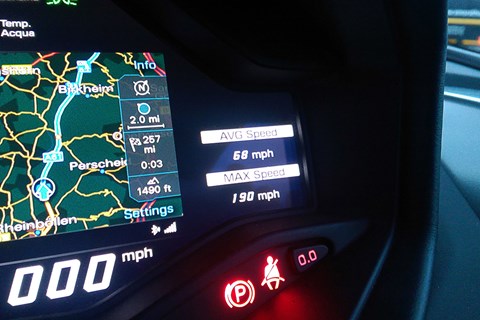
Suitably cowed, we elect to abandon the congestion and make a dash to the Sinsheim Auto & Tecknik Museum instead, where we stare at the Concorde and Tupolev Tu-144 mounted on the roof. Photography eats up further daylight, and soon we realise that with six hours of driving between us and our overnight in Bruges, regretfully we’ve got to head for home.
The traffic is lighter, and because I’ve been driving at such sustained high speeds all day, 120mph now feels like a cruise – awareness extended so much further up the road, I start contemplating whether everyone should be forced to drive as fast as they can occasionally, just to make everyday speeds safer. With the Huracan’s dynamic steering keeping it rock steady and the ceramic brakes holding my hand, it’s as if I’ve got all in the anticipation time in world. We plunge across Germany like… well, like a white arrow.
Then the moment arrives. Like some kind of corny movie set-up, just as the sun drops below the treeline we crest a hill to find dead straight derestricted dual carriageway that’s almost empty – the vague shape of a BMW in the distance. Accelerator mashed, that shape isn’t so vague anymore. And it isn’t getting out of the way. The road rises beyond it, then curves quite definitely to the right, so for the first time in the trip I find the headlight flasher with my thumb. Can only imagine the rear-view mirror madness the Huracan represents at this closing velocity. The BMW gets the message just as I’m preparing to fully abort, and I punch my right foot back to the carpet.
A sneaky glance tells me the gearbox automatically upshifts from sixth to seventh at 183mph – yes! – but I keep it pinned until I think – I think – I see 190 flash up on the digital speedo. Then it’s hard on the carbons to make the turn at the top of the hill with a decent margin of safety. Phew. Alex and I uncoil slightly, as I back the Lambo down and check the max speed display. 190mph. Uphill. Flipping yes. We’ve done it. Best not to wonder if we’d have hit 200 if that 1-series hadn’t been in the way.
By CJ Hubbard
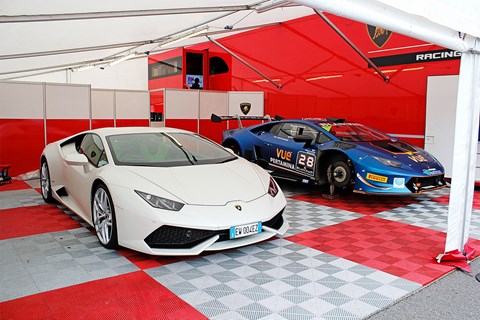
Month 3 running a Lamborghini Huracan: visiting Lambo’s race relations
The guys at the hand car wash are so taken with the Huracan they forget to give me my change. It’s five minutes down the road before I realise this – and since five minutes is quite a long way in the white wedge, I decide to pretend I am actually the kind of person who can afford this kind of car, and shrug. Drive one of these, you should tip well. It adds to the flamboyant brand image.
I’ve been thinking about image a lot recently. I do my best to take the time to talk to people who come up and ask about the Lambo – letting kids sit behind the wheel for a few minutes is the sort of small-scale positive action we can all take to make sure car enthusiasm survives into the second quarter of the 21st century – but the thing about the Huracan is that everybody loves it. In a way I’m not sure they would a Ferrari. People seem to get that you drive one of these with a sense of humour, rather than a stick up your arse. Raving bull, not prancing horse.
Anyway. You were probably wondering why I was getting it washed at all. Up until this point I’ve been letting Lamborghini do the cleaning, every time the Huracan’s had to ‘pop back’ to the dealership. Just minor niggles – a puncture, an AWD sensor – most amusing being the passenger side windscreen washer jet, which started spraying inside the luggage compartment instead of onto the screen. But today I’m off to watch the Lamborghini Super Trofeo at Silverstone, so I thought I’d better make it presentable.
Head of motorsport Giorgio Sanna jokes that it’s taken Lambo 50 years to go racing ‘professionally’, as the first proper department – Squadra Corsa – was only established in 2013. Since his final job in his previous role as Lamborghini’s chief test driver was developing the Huracan road car, he’s also the ideal person to explain the difference between this and the racing versions. There are two racers – the GT3, which races in the Blancpain Endurance series among others, and the Super Trofeo, which races in its own championship as a Blancpain support act. Silverstone is teeming with Lambos today.
The first major distinction is that the racers are rear-wheel drive. The GT3 is full-on racing car, deploying a dedicated chassis with ‘massive modification’, new suspension and downforce. The Super Trofeo is closer to the professional equivalent of a Huracan trackday toy. It keeps the road car chassis, engine and suspension kinematics (with upgraded springs and dampers), but gains a dedicated wiring loom, lightweight racing ’box and composite quick-release bodywork. The rollcage is a given, while swapping the two side-mounted radiators for a single, nose-mounted unit helps the racers keep going should they start trading paint. And since Super Trofeo features 30 cars racing across four skills-divergent classes, this does have a tendency to happen.
I can’t help asking whether the GT3 is faster than the Super Trofeo. ‘Yes. In theory,’ is the mischievous answer. Regs cap the GT3’s output, so the front-running Super Trofeos are only a second off the GT3 pole time at Silverstone. ‘What our customers enjoy in Super Trofeo is driving a car similar to the GT3 with a little bit more power and less downforce,’ Sanna explains. ‘It gives a better feeling because it’s less extreme. It’s part of the game.’ And watching from the stands, it looks like a good one.
By CJ Hubbard
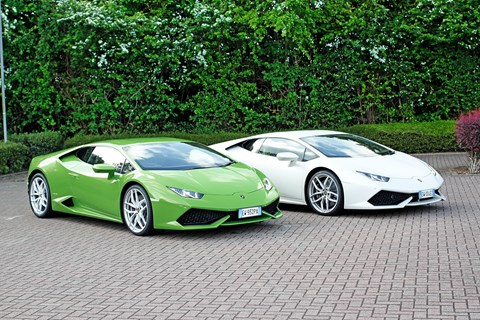
Month 2 running a Lamborghini LP610-4: green or white?
We get a lot of emails at work. Some are useful, some are exciting, and some contain unsolicited press releases, usually concerning surveys on behalf of giveourservicepublicity.com. Probably half a dozen of these a year will be about what the colour of your car says about you. Drive a red Daewoo Matiz? You must be very angry (and who could blame you?). Drive a silver Nissan Qashqai? You need to redress your lack of imagination before it deserts you altogether. A blue VW Jetta? You’re an international assassin slipping under the radar.
Drive a green Lamborghini Huracan? You must be more popular than God. Wait. Green?
Er, yes. For a brief few days I was CJ ‘two Lambos’ Hubbard, as a ‘Verde Mantis’ Huracan came to keep the white wedge company. There was a legitimate reason: the green car has the standard rather than the dynamic steering. Which is legitimate, because whenever someone wearing supercar-branded clothing approaches me to ask about the Huracan (this does actually happen), the first question they ask is ‘has it got the funny steering?’
Still, the steering isn’t the most interesting thing about the green car. The most interesting thing is what a difference the colour makes to the number of people that notice you. The white, it turns out, genuinely is subtle by Lambo standards whereas Verde Mantis could, in all likelihood, stop a riot. I’m not sure how many instances of whiplash it actually caused, but I felt lucky to avoid causing any inadvertent hospitalisation. Choose wisely – and I’m not talking about the steering, since both systems have merits and neither ruins the car.
By CJ Hubbard
Lamborghini Huracan diary notes: Cannonball Run what?
Wondering what the Cannonball Run movie reference was about in the opening report?
You’re welcome…
By CJ Hubbard
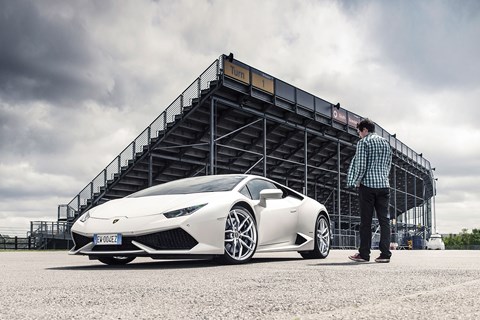
Month 1 running a Lamborghini Huracan LP610-4: the introduction to our long-term test
My new car is a Lamborghini. That looks like such a simple sentence, written down. But when spoken aloud it’s as if it becomes something utterly incomprehensible, like the plot to Mulholland Drive, or a Klingon thesaurus. I’m not sure I’ve murmured it to a single person who hasn’t done some kind of physical or verbal double take: ‘Your new car is a what…?!’ It’s pretty hilarious. But it’s also entirely true. Meet the White Wedge, ‘my’ new Huracan LP610-4.
Where to begin? I could tell you how I accelerated a recent house move entirely because I needed somewhere safe to park. Yes, I have moved house because of a car. But can you blame me? I don’t think so. I might also mention how my Saturday afternoons as a child were defined by repeat video shop rentals (remember those?) of the Cannonball Run movies, both of which feature an opening sequence involving a Lamborghini Countach behaving in what can only be described as an irresponsible manner. In the second movie, it’s even a (temporarily) white one. It doesn’t take much of a gander at the ‘Bianco Canopus’ exterior of the Huracan to see the family resemblance. This is literally a childhood dream come true.
But the reality of the situation is actually better. Instead of a something highly-strung, prone to histrionics and impossible to reverse without fear of financial catastrophe, here I have the ultimate expression of modern Lamborghini. A car with all the drama of Sant’Agata Bolognese combined with the intelligence of parent company Audi – an alliance the Italians are now keen to not only acknowledge but entirely embrace, exhibit one being the Huracan’s ‘hybrid’ chassis.
This structure, shared with the second-generation R8, matches Lamborghini’s carbonfibre expertise with Audi’s experience in aluminium. The result is a dual-material platform that is 50% stiffer yet 10% lighter than the Gallardo’s – propelled by a new dual-injection 5.2-litre V10 that now produces 602bhp and 413lb ft, 75% of which torque is available from just 1000rpm. Thank goodness for the new dual-clutch seven-speed gearbox, electronic four-wheel drive and ‘Lamborghini Piattaforma Inerziale’ inertial control system. Er, indeed.
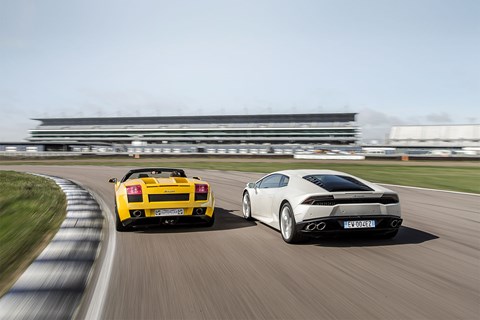
My point – and I was making one – is that this is a Lamborghini you can theoretically use every day. We can get into whether such a Lamborghini should exist another time (amongst the alternative perspectives being one that suggests the super in supercar should stand for super difficult to drive), since everyday aptitude is, Lamborghini says, what its customers have been asking for. So to use it every day is exactly what I intend to do. We have no mileage limit, and no usage restrictions.
To this everyday end, although the Bianco Canopus paint – a kind of quietly gorgeous matt pearlescent – isn’t quite in keeping with Lamborghini’s extrovert image, I’m glad of the relative subtlety. While loud pipes may save lives, loud colours do tend to attract the attention of the authorities, not to mention a particular subset of road users who think they own a fast car. As it is I’ve already encountered a number of individuals who seem determined to glue their X5 or A6 to the Lambo’s rear bumper, in apparent homage to their vehicle’s immense capability. Without wishing to sound like too much of a pillock, the Huracan does 0-62mph in 3.2sec; you may wish to re-evaluate your perspective.
Anyhoo. Counterpoint to the outside is the ‘Bicolour’ interior, which is part black, part eye-searing green. I thought I was going to hate it, but once over the initial shock of sliding down into Kermit the Frog’s loving embrace, I’ve quickly grown to enjoy it – the green adds the element of showmanship the exterior is attempting to eschew, and funks up what might otherwise be a slightly too Audified cockpit. For the record, I already love the combination of logically laid-out MultiMedia Interface infotainment and the more eclectic metal toggles that span the centre console. The 12.3in digital instrument cluster is also a hit.
Further options fitted include variable ratio Dynamic Steering, magneto-rheological variable dampers, lifting system to raise the nose over speed bumps and the essential reversing camera. The Huracan has three driving modes, Strada, Sport and Corsa, which manipulate the variable systems, the throttle map, the gearbox, the stability control and the extent to which the exhaust threatens to upset car alarms. The ‘Anima’ switch on the steering wheel makes it easy to flip between them.
Familiarisation is surprisingly straightforward. But in the end, if you’re anything like me, you’re still sat behind the wheel of a 602bhp supercar, with an itching right foot, too much imagination and a desperate, desperate desire not to appear in one of those ‘idiot crashes Lamborghini’ YouTube videos that tend to go tremendously viral. Which is why I thought I’d better find someone to help make sure I wasn’t going to stuff the thing during my first slip-road entry. Up pipes our James Taylor, who ‘knows a race instructor with a Gallardo’.
And so, two weeks after taking delivery, I find myself at Rockingham, chatting with Ryan Lindsay, who’s owned his bright yellow Gallardo Spyder for six years. At first encounter, he’s immensely impressed with the Huracan: ‘It makes my car look so old! And it’s so easy to drive!’ This last is a relief, but it’s the Dynamic Steering that I’m especially keen to understand. On the road, the variable-ratio rack seems most natural in its lightest Strada setting, the weightier Sport and Corsa feeling particularly artificial as you move off the straight-ahead. It’s a little disconcerting, and conspires to disrupt your faith in the front end – which is perhaps why some have referred to the Huracan as understeery. Turns out (no pun intended) you just need to go faster.
Rockingham’s Super Sportscar Circuit combines high-speed banking with a technical infield that includes a long, off-camber left, and is criss-crossed with interesting skidmarks as testimony to its foibles. The Huracan immediately feels absolutely mega. Who said Lamborghinis were built to pose, not to dance? With Ryan as expert, line-divining co-pilot (he spends a lot of time at Rockingham), pushing me to go faster, the Corsa steering weight suddenly seems the most natural thing in the world.
Although after a morning’s session I’m still not working the front end as hard as Ryan wants (‘You’re smooth, that’s the main thing. And you can left-foot brake without putting me through the windscreen’ – good to know), the moments when you get it absolutely right and feel the four-wheel drive hauling you out of a corner are divine. The carbon-ceramic brakes are superb, and the noise it makes, well, Ferrari can keep its new turbos. This isn’t just a furiously fast car, it’s also confidence-inspiring and rewarding. Knowing how well it behaves at these speeds has entirely erased my Dynamic Steering concerns on the road. We’re going to get along fine.
By CJ Hubbard
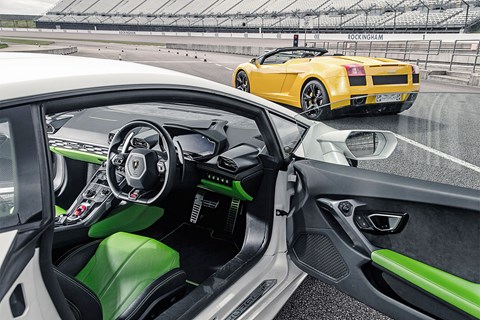
Preview: Lamborghini Huracan joins the fleet
The latest addition to the CAR magazine Our Cars long-term test fleet is… a Lamborghini Huracan LP610-4. And nope, we can’t believe it either.
Finished in matt white paint with a (gulp) Kermit green interior, it treads an interesting path between the demure and the outrageous, and has made quite the splash in the company car park – turning the heads of even the most automotively disinclined. Because, basically, it’s a Lamborghini.
We can immediately report that the Huracan can cope with speedbumps, makes a disgustingly arousing noise – thank the non-turbo 5.2-litre V10 for that – and is proving remarkably easy to live with everyday. Which is exactly how often we’re planning to drive it, although you won’t be surprised to hear we’ve already got a few adventures lined up as well.
You can find out the full spec of the car, and read more about the awkward getting-to-know-each-other stage in the July 2015 issue of CAR magazine, on sale now. Look out for more updates as soon as we’ve run out of petrol.
By CJ Hubbard